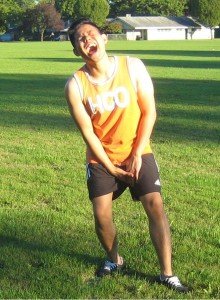Groin muscle pain is often due to a strain on the groin. This is strikingly comparable to any kind of strained or pulled muscle but occurs once the muscles in the interior thigh are stretched more than their normal limits. This results to tears on the small muscles that lead to swelling and pain. The groin muscles include the adductor longus, adductor magnus, adductor gracilis, pectineus and brevis.

These adductors are muscles with fan-like appearance in the upper thigh that pulls the legs together once they contract. These muscles also help stabilize the hip joint. The common cause of groin pain is muscle strain that results to localized pain in the groin. For a severe tear, it can result to an abrupt, acute pain that is accompanied by bruising and injury. It is painful to the touch and it increases when stretching the hamstrings and inner thigh. This injury often occurs during sudden change of direction while running, especially in court or field sports.
Difference between groin pull and hernia
The symptoms of a sports hernia can be mistaken for a groin strain or pull. The dull aching pain that worsens with exercise might be the only symptom of a sports hernia. As for inguinal hernia, it results to bulging protrusions in the lower abdomen that is quite noticeable. If hernia is suspected, it is best to consult your doctor.
How groin pain is treated
For immediate relief for groin pain, it is best to use the RICE method. Rest, ice, compression and elevation can effectively deal with strains and pulls. Instruct the individual to avoid any activities that will aggravate the pain for 1-2 weeks and gradually return to your activities.
Some athletes usually tape the groin in order to minimize pain and help protect from injury. The application of a special groin tape is typically used to easily tape the groin area.
When starting to increase the activity level, it is best to apply ice on the area after exercise in order to control the swelling. After the application of ice, wrap the thigh to keep it compressed for 15-20 minutes.
Over-the-counter medications for inflammation are helpful in minimizing pain and inflammation up to a week after the injury. Once the swelling subsides, the individual can start with gentle stretching exercises for the groin and eventually move on to strength training that involves low-intensity exercises.
Individuals can engage in running during the recovery phase but it must be gentle and gradual. Try to observe for signs of pain or increased tenderness and minimize the exercise routine if any develops. Always instruct the individual to stretch gently and do not force stretching. Returning to any activity is possible in just 2-3 weeks.
How to prevent a groin pull
Performing correct warm-up and stretch exercises is very useful to avert groin pulls. It is also best to gradually increase the time and intensity of the activity in order to prevent overuse and trauma to the muscles.
